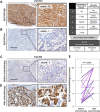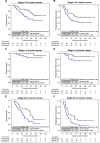The impact of EpCAM expression on response to chemotherapy and clinical outcomes in patients with epithelial ovarian cancer
- PMID: 28574829
- PMCID: PMC5546482
- DOI: 10.18632/oncotarget.17871
The impact of EpCAM expression on response to chemotherapy and clinical outcomes in patients with epithelial ovarian cancer
Abstract
Epithelial ovarian cancer is a highly lethal malignancy; moreover, overcoming chemoresistance is the major challenging in treating ovarian cancer patients. The cancer stem cell (CSC) hypothesis considers CSCs to be the main culprits in driving tumor initiation, metastasis, and resistance to conventional therapy. Although growing evidence suggest that CSCs are responsible for chemoresistance, the contribution of CSC marker EpCAM to resistance to chemotherapy remains unresolved.Here we have demonstrated that ovarian cancers containing high levels of EpCAM have a significantly much lower probability of achieving overall responsive rates after first-line chemotherapy. In addition, multivariate analysis revealed that EpCAM expression is an independent risk factor for chemoresistance, indicating that EpCAM expression is a predictive biomarker of chemotherapeutic response. Consistent with these clinical observations, in vitro assays, we found that the subpopulation of EpCAM-positive ovarian cancer cells shows a significantly higher viability compared with EpCAM-negative cells in response to cisplatin treatment by preventing chemotherapy-induced apoptosis, which is regulated by EpCAM-Bcl-2 axis. Furthermore, in an in vivo mouse model, platinum agents preferentially eliminated EpCAM-negative cells in comparison with EpCAM-positive cells, suggesting that the remaining subpopulation of EpCAM-positive cells contributes to tumor recurrence after chemotherapy. Finally, we also found that an increased expression of EpCAM is associated with poor prognosis in ovarian cancer patients.Our findings highlight the clinical significance of EpCAM in the resistance to chemotherapy and provide a rationale for EpCAM-targeted therapy to improve chemoresistance. Targeting EpCAM should be a promising approach to effectively extirpate the CSCs as the putative root of ovarian cancer.
Keywords: EpCAM; cancer stem cell; chemoresistance; ovarian cancer; prognosis.
Conflict of interest statement
The authors declare no conflicts of interest.
Figures





Similar articles
-
FOXM1 expression is significantly associated with chemotherapy resistance and adverse prognosis in non-serous epithelial ovarian cancer patients.J Exp Clin Cancer Res. 2017 May 8;36(1):63. doi: 10.1186/s13046-017-0536-y. J Exp Clin Cancer Res. 2017. PMID: 28482906 Free PMC article.
-
CD44 variant 6 is correlated with peritoneal dissemination and poor prognosis in patients with advanced epithelial ovarian cancer.Cancer Sci. 2015 Oct;106(10):1421-8. doi: 10.1111/cas.12765. Epub 2015 Sep 21. Cancer Sci. 2015. PMID: 26250934 Free PMC article.
-
Overexpression of the epithelial cell adhesion molecule is associated with a more favorable prognosis and response to platinum-based chemotherapy in ovarian cancer.J Gynecol Oncol. 2014 Jul;25(3):221-8. doi: 10.3802/jgo.2014.25.3.221. Epub 2014 Jul 3. J Gynecol Oncol. 2014. PMID: 25045435 Free PMC article.
-
Chemotherapy for Patients with BRCA1 and BRCA2-Mutated Ovarian Cancer: Same or Different?Am Soc Clin Oncol Educ Book. 2015:114-21. doi: 10.14694/EdBook_AM.2015.35.114. Am Soc Clin Oncol Educ Book. 2015. PMID: 25993149 Review.
-
Overcoming drug resistance in ovarian carcinoma.Curr Oncol Rep. 2001 Jan;3(1):19-26. doi: 10.1007/s11912-001-0038-z. Curr Oncol Rep. 2001. PMID: 11123865 Review.
Cited by
-
Discovery of differentially expressed proteins for CAR-T therapy of ovarian cancers with a bioinformatics analysis.Aging (Albany NY). 2024 Jul 18;16(14):11409-11433. doi: 10.18632/aging.206024. Epub 2024 Jul 18. Aging (Albany NY). 2024. PMID: 39033780 Free PMC article.
-
Presence and role of stem cells in ovarian cancer.World J Stem Cells. 2019 Jul 26;11(7):383-397. doi: 10.4252/wjsc.v11.i7.383. World J Stem Cells. 2019. PMID: 31396367 Free PMC article. Review.
-
EpCAM Signaling in Oral Cancer Stem Cells: Implications for Metastasis, Tumorigenicity, and Therapeutic Strategies.Curr Issues Mol Biol. 2025 Feb 14;47(2):123. doi: 10.3390/cimb47020123. Curr Issues Mol Biol. 2025. PMID: 39996844 Free PMC article. Review.
-
A Novel Bispecific Antibody for EpCAM-Directed Inhibition of the CD73/Adenosine Immune Checkpoint in Ovarian Cancer.Cancers (Basel). 2023 Jul 17;15(14):3651. doi: 10.3390/cancers15143651. Cancers (Basel). 2023. PMID: 37509310 Free PMC article.
-
Regulation of SUMOylation Targets Associated With Wnt/β-Catenin Pathway.Front Oncol. 2022 Jun 30;12:943683. doi: 10.3389/fonc.2022.943683. eCollection 2022. Front Oncol. 2022. PMID: 35847921 Free PMC article. Review.
References
-
- Miranda F, Mannion D, Liu S, Zheng Y, Mangala LS, Redondo C, Herrero-Gonzalez S, Xu R, Taylor C, Chedom DF, Karaminejadranjbar M, Albukhari A, Jiang D, et al. Salt-Inducible Kinase 2 Couples Ovarian Cancer Cell Metabolism with Survival at the Adipocyte-Rich Metastatic Niche. Cancer Cell. 2016;30:273–289. - PubMed
-
- Yap TA, Carden CP, Kaye SB. Beyond chemotherapy: targeted therapies in ovarian cancer. Nat Rev Cancer. 2009;9:167–181. - PubMed
-
- Agarwal R, Kaye SB. Ovarian cancer: strategies for overcoming resistance to chemotherapy. Nat Rev Cancer. 2003;3:502–516. - PubMed
MeSH terms
Substances
LinkOut - more resources
Full Text Sources
Other Literature Sources
Medical
Miscellaneous

